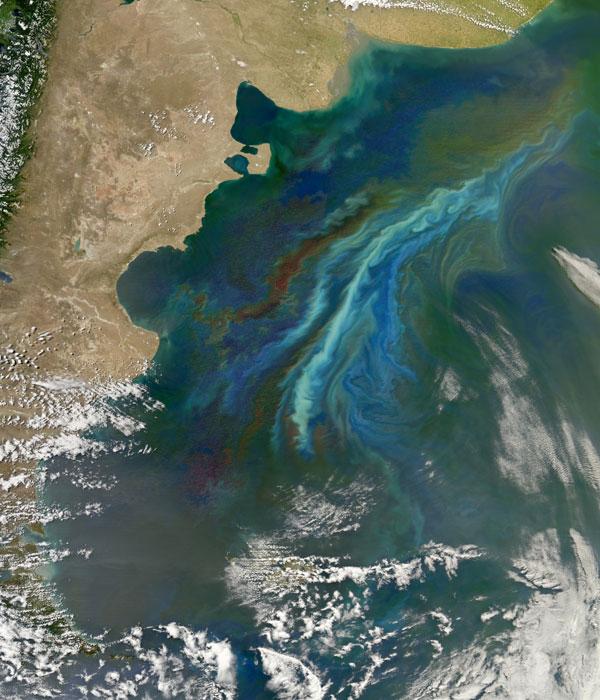
Swirling Ocean Currents Help Spread Sea Life

Puzzling clusters of microscopic plants in the ocean are likely caused by giant, swirling circular currents, scientists now reveal, providing a new view of how life travels around the globe.
About half of the Earth's oxygen is generated by tiny, single-celled plants known as phytoplankton that live in the planet's oceans, rivers and lakes. To convert sunlight to the energy they use to fuel themselves, these plants rely on chlorophyll, the same green molecule seen in plants on land. Because they make use of this telltale chemical marker, looking for this pigment in the oceans can tell where and how densely concentrated these plants are.
Satellite observations had shown that phytoplankton, the main foundation of the ocean food chain, were concentrated in an unusually patchy manner, and that clusters often migrated slowly westward. Now, by analyzing 10 years of satellite measurements of chlorophyll concentrations, scientists have discovered this pattern is likely caused by circular motions of thousands of giant currents called mesoscale eddies that stretch about 125 miles (200 kilometers) wide.
"There is a wide range of eddy strengths and sizes, but water typically circulates around an eddy — the eddy 'rotates' — at speeds of 5 to 15 miles per day," said study researcher Roger Samelson, a physical oceanographer at Oregon State University. "In the part of the eddy where the rotational currents are the strongest, it typically takes about 15 days for a parcel of water to complete a trip all the way around the eddy."
Moving life
The eddies move across the ocean slowly, "mostly due westward, at speeds of 2 to 4 miles per day," Samelson added. "They move faster near the equator, and slower at high latitudes. Since they persist for months and sometimes years, they can move hundreds or thousands of miles westward."
By carrying phytoplankton vast distances, these eddies provide "a new mechanism that can connect distant ocean ecosystems, like strong winds that disperse seeds or other terrestrial life," Samelson told OurAmazingPlanet. "For example, microscopic fish larvae from a coral reef might be transported to another region hundreds, if not thousands, of miles away."
Sign up for the Live Science daily newsletter now
Get the world’s most fascinating discoveries delivered straight to your inbox.
"We are all familiar with how the physical environment of the land surface shapes terrestrial ecosystems, from dry desert plains to forested mountains," he said. "In the ocean, most life lives within the water, and it is the physical characteristics and circulation of the water that control the environment. These observations represent a particularly clear and striking example of that control."
Sharper picture needed
The current generation of satellites "provides a coarse picture of the eddies, just enough for us to know that they are there and provide a basic statistical description," Samelson said. "In order to understand where they come from, what happens to them, and what effect they have on the state of the ocean and its biology, we need a sharper, higher-resolution picture."
"New satellite technologies being developed by NASA promise to provide this sharper picture, but unfortunately won't launch until the end of the decade," he added. "It is very frustrating to find such exciting results but not to be able to follow up on the details from higher-resolution satellite measurements until nearly a decade from now."
And better satellite technology isn't the only requirement for a better understanding of exactly what's happening in these ocean eddies.
One limitation of satellite methods "is that they can only measure what is happening at or very near to the surface of the ocean," Samelson said. "In order to get a full picture, we need to combine these surface measurements with deeper measurements made with instruments in the water, from ships, on moorings or on freely drifting floats or autonomous vehicles. The possibility of combining all of these types of measurements from new and classical technologies makes this a very exciting time in ocean science."
The scientists detailed their findings in the journal Science online Sept. 15.
This story was provided by OurAmazingPlanet, a sister site to LiveScience.










